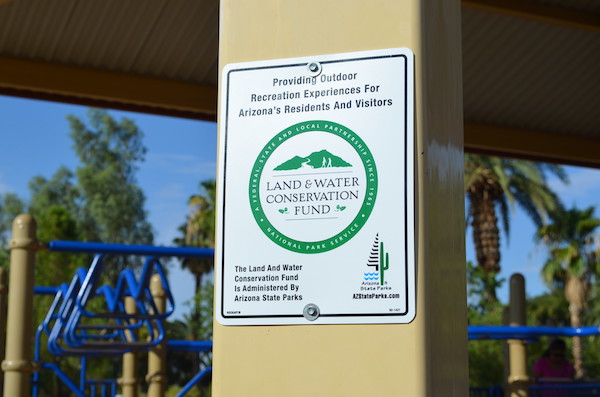SEJournal Online is the digital news magazine of the Society of Environmental Journalists. Learn more about SEJournal Online, including submission, subscription and advertising information.
 |
| New funding for the Land and Water Conservation Fund will mean more money for local recreation areas, such as this park in Phoenix. Photo: U.S. Department of Interior. Click to enlarge. |
Reporter’s Toolbox: Tracking Local Land & Water Conservation Fund Sites
By Joseph A. Davis
Signs are that Congress may soon enact a bill forcing permanent funding of the Land and Water Conservation Fund, or LWCF, which takes a portion of federal revenue from offshore drilling and puts it primarily into acquisition of land and water rights for public recreation.
Since many of the land and water areas are owned by state and local governments, this potential new funding flow may well mean new money for an outdoor recreation area near you.
And there are some handy tools below for finding your local projects.
A political ‘loose ball’
The legislation setting up the LWCF was originally passed by Congress back in 1965, and it has been a political “loose ball” for much of the time since. At its heart is a political trade-off between something conservationists don’t want (drilling) and something they do want (land and water). Both the oil lobby and the green lobby get something from the deal.
Because the money goes to a vast number of Congressional districts, it is easy to find votes for the LWCF — at least in theory. While the law segregates certain offshore oil and gas royalties into the fund, the law also said that the funds must be appropriated by Congress.
Some in Congress saw this as an invitation to pillage, and over the years Congress diverted some of the money to other pet projects. Congress’ committee structure tempts powerful committee chairs to take LWCF money hostage.
New funding for the LWCF matters
to environmental journalists because a flood of grants
to local parks and hunting and fishing spots
may be coming soon, and local audiences
will want to know about it.
Moreover, since the so-called Sagebrush Rebellion flowered in the 1970s, many Western politicians saw land acquisition (especially federal land acquisition) as a bad thing. So they sometimes sabotaged the LWCF. It’s complicated.
In the current Congress, there are signs the LWCF could be permanently re-established. The original legislative authorization expired in Sept. 2018, but as part of a comprehensive public lands bill, Congress permanently reauthorized it in Feb. 2019.
Now further legislation is moving that would skip appropriations and require spending at the full authorized level of $900 million per year. It was approved June 19 (subscription required) by the House Natural Resources Committee, and a Senate version, S 1081, has a bipartisan list of 43 cosponsors. Prospects for enactment seem good.
This all matters to environmental journalists because a flood of grants to local parks and hunting and fishing spots may be coming soon, and local audiences will want to know about it.
Where the data comes from & how to use it smartly
There are databases for finding your local projects. Alas, they are far from perfect, complete or up to date. The fact is what is funded locally will depend to some extent on federal and state decisions that haven’t been made yet.
But because there is already a long list of projects that have been previously funded, and may be waiting for further funding, reporters have some helpful starting points.
Check in with your state recreational land management agencies and the National Park Service (which administers much of the federal part of LWCF). Here’s an old contact list.
Also check with state and local conservation groups, who may already be involved.
Here are other resources:
- The nonprofit journalism outlet InvestigateWest compiled a database a few years ago that you can search by state. SEJournal previously reported on how that database could be used to track illegal diversion of LWCF grants.
- The Wilderness Society, a nonprofit conservation advocacy group, has compiled a pretty good map-based database of historical projects, with data through 2014.
- Land & Water Conservation Fund Coalition, a nonprofit advocacy group, offers its own online, map-based presentation of The Wilderness Society’s database.
- National Park Service’s LWCF office offers its own project lists [Editor’s Note: The project list link did not work at publication time, but you may want to try it yourself later]. You can get a PDF version here. If you are a geek, look here for starting tools for “scraping” PDF files to extract structured data.
- Plus, here’s a mid-2017 SEJournal TipSheet on political battles over the LWCF and how to report on it locally.
Joseph A. Davis is a freelance writer/editor in Washington, D.C. who has been writing about the environment since 1976. He writes SEJournal Online's TipSheet and Reporter's Toolbox columns. Davis also directs SEJ's WatchDog Project and writes WatchDog Tipsheet, and compiles SEJ's daily news headlines, EJToday.
* From the weekly news magazine SEJournal Online, Vol. 4, No. 31. Content from each new issue of SEJournal Online is available to the public via the SEJournal Online main page. Subscribe to the e-newsletter here. And see past issues of the SEJournal archived here.













 Advertisement
Advertisement 



